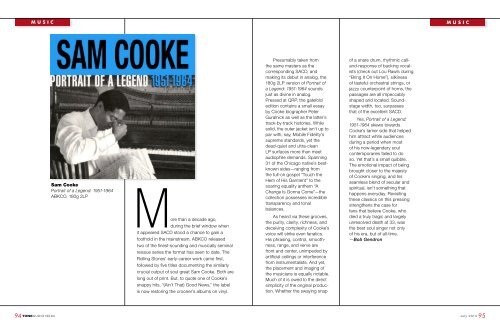Create successful ePaper yourself
Turn your PDF publications into a flip-book with our unique Google optimized e-Paper software.
MUSIC<br />
MUSIC<br />
Sam Cooke<br />
Portrait of a Legend: 1951-1964<br />
ABKCO, 180g 2LP<br />
M<br />
ore than a decade ago,<br />
during the brief window when<br />
it appeared SACD stood a chance to gain a<br />
foothold in the mainstream, ABKCO released<br />
two of the finest-sounding and musically seminal<br />
reissue series the format has seen to date. The<br />
Rolling Stones’ early-career work came first,<br />
followed by five titles documenting the similarly<br />
crucial output of soul great Sam Cooke. Both are<br />
long out of print. But, to quote one of Cooke’s<br />
snappy hits, “(Ain’t That) Good News,” the label<br />
is now restoring the crooner’s albums on vinyl.<br />
Presumably taken from<br />
the same masters as the<br />
corresponding SACD, and<br />
making its debut in analog, the<br />
180g 2LP version of Portrait of<br />
a Legend: 1951-1964 sounds<br />
just as divine in analog.<br />
Pressed at QRP, the gatefold<br />
edition contains a small essay<br />
by Cooke biographer Peter<br />
Guralnick as well as the latter’s<br />
track-by-track histories. While<br />
solid, the outer jacket isn’t up to<br />
par with, say, Mobile Fidelity’s<br />
supreme standards, yet the<br />
dead-quiet and ultra-clean<br />
LP surfaces more than meet<br />
audiophile demands. Spanning<br />
31 of the Chicago native’s bestknown<br />
sides—ranging from<br />
the full-on gospel “Touch the<br />
Hem of His Garment” to the<br />
soaring equality anthem “A<br />
Change Is Gonna Come”—the<br />
collection possesses incredible<br />
transparency and tonal<br />
balances.<br />
As heard via these grooves,<br />
the purity, clarity, richness, and<br />
deceiving complexity of Cooke’s<br />
voice will strike even fanatics.<br />
His phrasing, control, smoothness,<br />
range, and verve are<br />
front and center, unimpeded by<br />
artificial ceilings or interference<br />
from instrumentalists. And yet,<br />
the placement and imaging of<br />
the musicians is equally notable.<br />
Much of it is owed to the direct<br />
simplicity of the original production.<br />
Whether the swaying snap<br />
of a snare drum, rhythmic calland-response<br />
of backing vocalists<br />
(check out Lou Rawls during<br />
“Bring It On Home”), silkiness<br />
of tasteful orchestral strings, or<br />
jazzy counterpoint of horns, the<br />
passages are all impeccably<br />
shaped and located. Soundstage<br />
width, too, surpasses<br />
that of the excellent SACD.<br />
Yes, Portrait of a Legend:<br />
1951-1964 skews towards<br />
Cooke’s tamer side that helped<br />
him attract white audiences<br />
during a period when most<br />
of his now-legendary soul<br />
contemporaries failed to do<br />
so. Yet that’s a small quibble.<br />
The emotional impact of being<br />
brought closer to the majesty<br />
of Cooke’s singing, and his<br />
seamless blend of secular and<br />
spiritual, isn’t something that<br />
happens everyday. Revisiting<br />
these classics on this pressing<br />
strengthens the case for<br />
fans that believe Cooke, who<br />
died a truly tragic and largely<br />
unresolved death at 33, was<br />
the best soul singer not only<br />
of his era, but of all-time.<br />
—Bob Gendron<br />
94 TONE AUDIO NO.64<br />
July 2014 95




